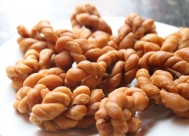Mid 2014, the China Daily carried an interesting article about a producer of a very traditional Chinese food, mahua (fried dough twists, whose name literally means ‘hemp flour’), that intends to finance its big plans through the modern means of offering its stock to the public.
This is an excellent occasion for a new item of my ‘What on earth are . . . ‘ blogs.
Guifaxiang, based in the northern port city of Tianjin, plans to make its debut on the Shenzhen Stock Exchange.
Founded in 1927, Guifaxiang would become the first publicly listed maker of such products in China if its plan wins approval.
The company realised more than 96% of its sales (RMB 462 mln in 2013) from the Tianjin market. 77% of this revenue was derived from mahua. It plans to raise RMB 570 mln through its initial public offering.
With the money raised, Guifaxiang plans to invest RMB 287 mln in expanding its production capacity. It produced 7748 mt of mahua last year, according to the prospectus.
The pictures in this blog show plain mahua and those produced by Guifaxiang
The company also plans to speed up its expansion in China by opening 19 stores within three years of listing, with 10 stores in Tianjin, and nine others in the cities of Beijing, Shanghai, Shijiazhuang, Shenyang and Xi’an.
Here is a basic traditional recipe for mahua
Ingredients
| Regular flour | 200 gr |
| Eggs | 1 |
| Baking powder | 1.5 gr |
| Salt | 2 gr |
| Water | 50 gr |
- Put all ingredients in a bowl and mix until you have a smooth dough. Leave the bowl for 30 minutes with a lid loosely placed on top.
- Roll out the dough and cut out strips. Twist the strips into the typical mahua shape.
- When the oil has reached the proper temperature, first through in one. After its has changed colour, through in the other mahua.
Modern industrial recipes also use: yeast, emulsifiers, sweeteners, butter, butter and cream flavours and sugar.
So what are the financial prospects for this stock? According to the prospectus, the company sold the mahua at RMB 47 per kg on average, making a profit of RMB 27.66 per kg. That seems quite reasonable. However, Guifaxiang does not seem to expect a lot of foreign interest, as its website is exclusively in Chinese.
Good prospects(?)
However, Chinese analysts seem to have high hopes for mahua, usually ranked among the ‘leisure foods‘ in Chinese statistics. I recently picked up two reports dedicated to this traditional snack; one concentrating on volumes, the other introducing the ways local companies develop their own special types of mahua.
The following graph shows the development of the mahua market in the past few years. The unit is RMB 100 mln. The researchers estimate that the value of this market will rise to RMB 6 billion in 2016.
Regional varieties
Local variation manifests itself in flavour and texture. The main region, the Beijing – Tianjin area, produces relatively hard and crispy mahua. They are sometimes filled with sesame seeds or other additional flavourings. When you move on the west, to Shanxi, the mahua become softer, and are usually kept plain. There are also halal mahua in Ningxia.
Another region famous for its mahua is Shanzhou County of Sanmenxia (Henan). The sales of mahua have considerably increased the income for the farmers in Shanzhou. Mahua have been produced there in Daying village for generations and the snack can be dated back to the Qing Dynasty (1644-1911). The product has generated an output of RMB 28 million in 2015.
This map of China indicates the regions where mahua are popular, with small pictures of typical local variations in preparing and consuming mahua.
Mahua snacks
A number of companies have launched fingerfood-size mahua as snacks. The following picture shows those of Kaqile.
Ingredients:
Wheat flour, glutinous rice meal, rice meal, vegetable oil, sugar, maltose, white sesame, black sesame, salt, additive (callcium carbonate)
Mahua as Local snack
Jinweinong is positioning its mahua snacks as a local specialty from Tianjin.
Ingredients:
Wheat flour, vegetable oil, sugar, osmanthus flower, Fujian ginger, white and black sesame, peanuts, green and red strips, sodium bi-carbonate
Peter Peverelli is active in and with China since 1975 and regularly travels to the remotest corners of that vast nation. He is a co-author of a major book introducing the cultural drivers behind China’s economic success.






